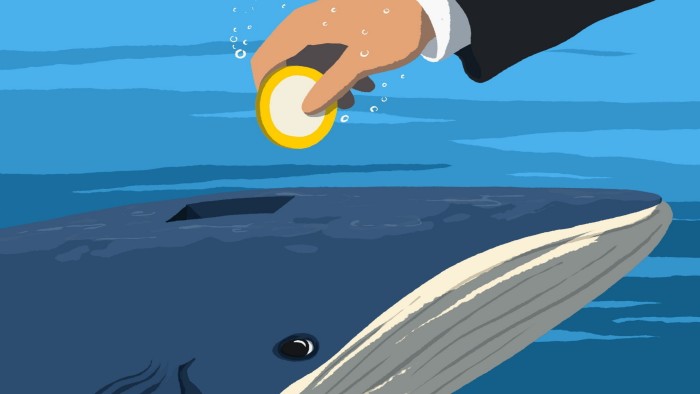Turning whales into carbon-based assets won’t be easy


Roula Khalaf, Editor of the FT, selects her favourite stories in this weekly newsletter.
The writer is a science commentator
Whale poo is like environmental gold dust. It is rich in iron, phosphorus and nitrogen, among the nutrients that phytoplankton, the algae at the bottom of the marine food chain, need to grow.
Phytoplankton produces more than half of the world’s oxygen and sucks as much carbon dioxide out of the atmosphere as four Amazon rainforests. More whales equals more phytoplankton — and therefore more carbon removal. According to Connel Fullenkamp, an economics professor at Duke University in North Carolina, that equation renders great whales, or rather their carbon capture and sequestration services, a potentially valuable and tradeable asset.
This logic underlies the Whale Carbon Plus Project, a joint effort to work out the monetary value of great whales and to create an associated financial market that rewards investors with carbon credits. Critically, a portion of investors’ money will be channelled into whale conservation and restoration. “Ultimately, we’re trying to put nature back as something that’s valued in our economy,” says Fullenkamp, whose research focuses on the development and regulation of financial markets.
It is a smart idea on paper: introducing the profit motive may succeed in protecting the world’s natural resources where governments, industry, environmentalists and philanthropists have largely failed.
One Must-Read
This article was featured in the One Must-Read newsletter, where we recommend one remarkable story each weekday. Sign up for the newsletter here
But setting up whales as a carbon-based asset entails several tricky steps. First, putting a dollar value on a great whale and its services means carefully quantifying claims for its carbon impact. Fullenkamp and fellow economist Ralph Chami, who co-founded the environmental consultancy Blue Green Future, one of the project partners, put the rough value of a great whale at about $2.5mn-$3mn over a 60-year lifespan. That estimate is based on the value of carbon absorbed by the phytoplankton that it and its descendants help to produce, plus the estimated 33 tonnes of carbon dioxide sequestered in its body (after death, whales sink to the ocean floor and keep the gas locked in for centuries), plus revenues from related tourism such as whale-watching.
Second, the project means assigning ownership to the animals, a complex matter for migratory creatures that swim past multiple countries. And third, any resulting financial product would need to be independently verified and audited.
Investors, whether individual or institutional, would then buy notes or bonds, with dividends paid out as carbon credits instead of cash. Some of the proceeds would be used to restore the total number of great whales (comprising 13 species, including the blue whale) from their current population of more than a million to the estimated 4mn-5mn that swam the oceans before industrialised whaling.
The whale-sized effort is worth it, Fullenkamp insists: if governments, economists and environmentalists can “put our heads together, there’s this new pie, this new asset class that didn’t exist before” from which revenues could flow.
While certifying that the money actually goes to saving the animals is critical, there is a growing demand for ethical investing, with sustainability bonds and green bonds gaining popularity.
There is also belated recognition that traditional economic models neglect the value of natural resources. A 2021 review by Sir Partha Dasgupta, at Cambridge university, described nature as a blind spot in economic thinking: destroying woodland to produce a shopping centre records the increase in produced capital, measured in terms of gross domestic product, but not the loss in carbon absorption nor the rise in soil erosion.
We have collectively allowed the natural assets on which we all depend to be depreciated off the books. Biodiversity is declining faster now than at any other time in history: a million animal and plant species are thought to be threatened with extinction.
Monetising whales will take years to get right, though seagrasses and mangroves, also important carbon sinks, could become an asset within two years.
“Some people have called this a Ponzi scheme and whale-whispering, airy-fairy nonsense,” Fullenkamp admits. “And if I tried to sell you this stuff today, I’d be ripping you off. What we’re trying to do is build this very carefully because, frankly, I don’t want to go to jail for fraud.”
Unlike crypto, say, there is something real — natural capital — underlying such assets. In any case, putting a dollar value on nature’s carbon sinks and other treasures, cannot be worse than not valuing them at all.
Climate Capital

Where climate change meets business, markets and politics. Explore the FT’s coverage here.
Are you curious about the FT’s environmental sustainability commitments? Find out more about our science-based targets here
Comments